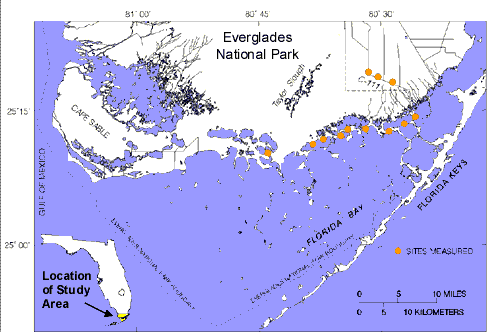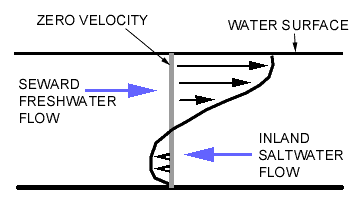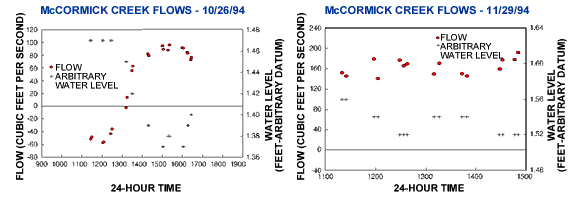U.S. Department of the Interior
U.S. Geological Survey
FS-135-96
Freshwater Discharge to Florida Bay
Importance of Flow Info | Acoustic Techniques | Preliminary Measurements and Results | Project Plans
The South Florida Ecosystem Program is a collaborative effort by Federal agencies, working with State and local agencies, to help resolve land-use demands and water-supply issues in south Florida. The role of the U.S. Geological Survey in the program is to provide scientific insight into south Florida's hydrology and geology, which are an integral part of the fragile ecosystems of the Everglades, Florida Bay, and the Florida Keys. Historical changes in water-management practices to accommodate a large and rapidly growing urban population along the Atlantic coast, as well as intensive agricultural activities, have resulted in a highly managed hydrologic system with canals, levees, and pumping stations. These structures have altered the hydrology of the Everglades ecosystem, including Florida Bay. Currently, there are plans to change the quantity of water delivered to Everglades National Park and Florida Bay to restore the natural flow of the system.
Florida Bay, home to several endangered species, is a valuable breeding ground for marine life and an important recreational and sport fishing area. Florida Bay (Fig. 1) encompasses about 850 square miles in total area with an average depth of less than 3.5 feet. It is bordered by the mainland portion of Everglades National Park to the north, the Florida Keys to the east and south, and is open to the Gulf of Mexico to the west. During the last decade, Florida Bay has experienced algal blooms and seagrass die-offs which are signals of ecological deterioration that has been attributed to an increase in salinity and nutrient content of bay waters. Salinity and nutrient content are directly related to the amount and quality of freshwater that enters the bay and to flow patterns within the bay. Restoration of the Florida Bay ecosystem requires a better understanding of the linkage between the amount of water and nutrients flowing into the bay and the salinity and quality of the bay environment.

Figure 1. Site locations of discharge measurements into Florida Bay.
Importance of Flow Information for Ecosystem Management
As part of the South Florida Ecosystem Program, the U.S. Geological Survey, in collaboration with Everglades National Park, the U.S. Army Corps of Engineers, and the South Florida Water Management District, is conducting a study to measure flows into Florida Bay. Information from this study will be used in conjunction with data from other studies to help determine the effects of changes in water deliveries to Everglades National Park on the Florida Bay ecosystem. Flow into Florida Bay is closely related to sediment transport, salinity, and chemical characteristics of the bay, which in turn, determine and interact with biological characteristics. Additionally, freshwater-inflow data will be used as input to hydrodynamic models of Florida Bay, for calibration of hydrologic models of the mainland, and for water-budget determinations for south Florida---all of which are essential elements for resource management and the ecosystem restoration.
In Autumn 1994, unusually high flow resulted from a tropical depression in September and Tropical Storm Gordon in November. High flows provided a unique natural experiment. Measurements by the U.S. Geological Survey linked high flows to salinity changes in the bay, thus duplicating the effects anticipated from the future restoration activities of the U.S. Army Corps of Engineers.
Acoustic Techniques for Flow Measurement
Prior to the development of currently available acoustic instruments, it was very difficult to gage flows in streams discharging into Florida Bay. Standard methods for field data collection and flow computations are impractical and inaccurate because of the low velocities, flow reversal, and bi-directional flow in which high-salinity water flows inland under freshwater flowing out to the bay (Fig. 2). With today's state-of-the-art acoustic instrumentation, such as the Acoustic Velocity Meter (AVM) and the Acoustic Doppler Current Profiler (ADCP), it is possible to accurately gage flows in this environment because of the ability of these instruments to quickly measure low or rapidly changing water velocities, even during stratified or bidirectional flow. AVM systems have proven to be accurate instruments in the measurement of water velocities along a horizontal plane across a stream and can be permanently installed to collect continuous velocity data that, along with water-level data, are used to produce continuous records of discharge.

Figure 2. Vertical velocity profile for bidirectional flow.
ADCP instruments are used to measure water velocities in three dimensions. These measurements are then used to calculate the total flow through a stream section at a given time. The ADCP uses the Doppler shift from four acoustic beams sent downward in set angles to measure the velocity of water, depth, and distance traveled across the stream transect. Field measurements made with the ADCP's are used to develop relations between AVM velocities and discharge at gaged sites.
Preliminary Measurements and Results
With the assistance of Everglades National Park, discharge measurements were made with ADCP's at the major streams flowing into Florida Bay (Fig. 1). Results of these measurements verified the applicability of ADCP's for discharge measurements in these environmental conditions, provided data on high flows into the bay, and helped to understand the flow patterns for each of the measured streams. Results of flows measured at McCormick Creek are presented here to illustrate the variability of flow patterns in the streams. Figure 3 shows flows measured at McCormick Creek on October 26, 1994, and November 29, 1994. Flows measured in October show what appears to be tidally affected flows with a complete flow reversal, and those measured in November show higher inflow to the bay, overcoming the tidal-like flow reversal.

Figure 3. McCormick Creek flows. Higher flows in November diminished the effects of tide; no flow reversal observed.
Project Plans
These activities are part of a larger plan to measure flows into Florida Bay. Project plans are to instrument selected streams flowing into Florida Bay with AVM's, temperature and specific conductance sensors in order to measure most of the total freshwater flow from the mainland into the bay. All proposed sites are located along the mainland coast of eastern Florida Bay and represent most of the freshwater flowing south into the bay from Taylor Slough and the C111 Canal basins. Monthly ADCP discharge measurements are planned for rating AVM systems, and monthly collection of water samples are planned for total nutrient analysis. This work will be coordinated with activities from other agencies and institutions who need simultaneous flow data during biological or chemical samplings.
For more information contact:
Related information:
![]() Click here for a printable version of this fact sheet (note: document will
open in a new browser window)
Click here for a printable version of this fact sheet (note: document will
open in a new browser window)
Eduardo Patino
U.S. Geological Survey
9100 NW 36th Street, Suite 107
Miami, FL 33178
Telephone: (305) 526-2895
SOFIA Project: Freshwater Flows into Northeastern Florida Bay
U.S. Department of the Interior, U.S. Geological Survey, Center for Coastal Geology
This page is: http://sofia.usgs.gov
/publications/fs/135-96/index.html
Comments and suggestions? Contact: Heather Henkel - Webmaster
Last updated:
11 October, 2002 @ 09:31 PM
(KP)
